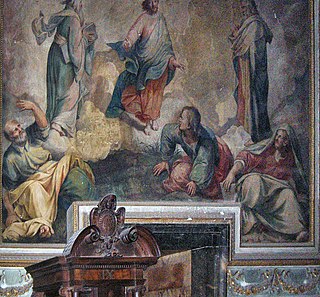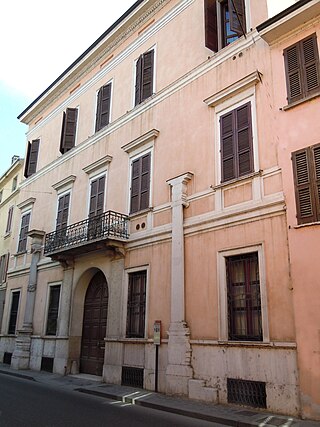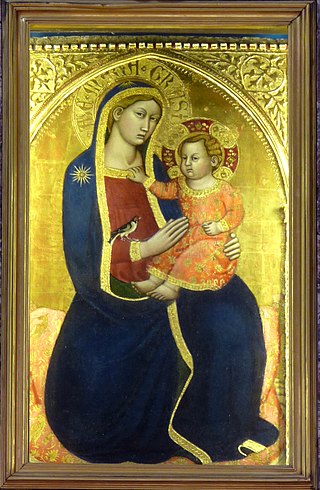
Cristoforo Agosta, Agosti, or Augusta (16-17th century) was an Italian painter of the Mannerist style.

Cristoforo Agosta, Agosti, or Augusta (16-17th century) was an Italian painter of the Mannerist style.
Agosta was born in Casalmaggiore. He was a pupil of Giovanni Battista Trotti and active in Cremona. [1] The 18th-century art historian Giovanni Battista Zaist assigned to him the Marriage of Santa Caterina, once in the church of San Domenico in Cremona (now in the Pinacoteca of Cremona). [2] [3]

Cesare Aretusi was an Italian painter of the late-Renaissance period.

Andrea dell'Asta was an Italian painter of the late-baroque period.
Giovanni Battista Baiardo was an Italian painter of the Baroque period.

Durante Alberti was an Italian painter of the late-Renaissance period.
Giovanni Antonio Amato or Amati was an Italian painter of the Renaissance period. Born in Naples, he copied the style of Pietro Perugino.
Ambrogio Besozzi or Giovanni Ambrogio Besozzi (1648–1706) was an Italian painter of the Baroque period.
Giacomo Apollonio was an Italian painter of the late-Renaissance and early-Baroque periods.

Giovanni Giacomo Barbelli was an Italian painter of the Baroque period, active in Lombardy. He was a canvas and fresco painter known for his religious and mythological scenes that decorate many churches and residences in Lombardy. He was a highly skilled draughtsman and a brilliant colorist. His work shows an inventive imagination and a thorough knowledge of perspective.
Francesco Bassi was an Italian painter active in the early-Baroque period, mainly in his hometown of Cremona, but also in Venice. He was also known as Francesco Maria Bassi the elder.

Giovanni Battista Benaschi, or Beinaschi, (1636–1688) was an Italian painter and engraver active in the Mannerist and Baroque style.
Giovanni Battista Bellandi was an Italian sculptor, active in Milan for its elaborately decorated Cathedral.
Antonio Beltrami (1724–1784) was an Italian painter active in the late-Baroque and Neoclassic periods. He was born in Cremona. He was a pupil of Francesco Boccaccino, who emerged from the school of Carlo Maratta. His older brother, Giovanni Battista was an engraver.
Lorenzo Bergonzoni was an Italian painter of the Baroque period. He was born and active in Bologna. He was first a pupil of Giovanni Battista Bolognini, but afterwards studied under Guercino in Cento. He is also called Lorenzo Bergunzi. He became known mostly as a portrait painter at Bologna.
Giovanni Battista Bertusio was a painter of the early-Baroque period, active in Bologna. He trained initially under Denys Calvaert, then under Ludovico and Agostino Carracci. He married the painter Antonia Pinelli.

Francesco Brenti was an Italian painter of the Mannerist style, active in Cremona 1612–1620. He appears to have trained with Giovanni Battista Trotti.

Simone Brentana was an Italian painter of the Baroque period, active in Verona. He was born in Venice to Domenico Brentana, but became orphaned by age nine. After a prolonged desultory education in various fields including music, he trained as a painter in Venice with Pietro Negri, frequenting the Accademia di Belle Arti, moving in 1685 to Verona, where most of his paintings are located.

Giovanni Battista Bertani (1516–1576) was an Italian painter and architect of the late Renaissance period. He trained with Giulio Romano in Mantua, and was promoted after Romano's death to the post of prefect of the ducal studio (fabbriche). Painters who assisted him over the years include his brother Domenico, as well as Giovanni Battista del Moro, Geronimo Mazzuola, Paolo Farinato, Domenico Brusasorci, Giulio Campi, and Paolo Veronese. He is said to have completed a partial translation of the work of Vitruvius.

Giovanni Battista Belluzzi (1506–1554), also known as Giovanni Battista di Bartolomeo Bellucci and as Il Sanmarino, was a Sammarinese architect and military engineer. He was born in San Marino on September 27, 1506 and at 18 years of age was sent by his father to Bologna, to learn commerce under Bastiano di Ronco, a merchant of the Guild of Wool. After two years, he returned to San Marino, where he set up a wool business of his own. His first wife, Cagli, died shortly after they were married. His second wife was the daughter of Girolamo Genga (1467–1551). The couple lived with Girolamo Genga, from whom Giovanni learned architecture. In 1541, his second wife died, leaving Giovanni to raise two sons. In 1543, Giovanni entered into the service of Cosimo I de' Medici, Grand Duke of Tuscany, as an engineer. He designed fortifications for Florence, Pistoia, Pisa and San Miniato and also wrote a book on military architecture. He was wounded in the siege of Montalcino and was killed by enemy fire in a fortress of Aiuola.
Stefano Ticozzi (1762-1836) was an Italian art historian.

Jacopo di Michele, also called Jacopo Gera, Iacopo di Michele, or Gera da Pisa is a 14th-century painter, active mainly in Pisa and elsewhere in Tuscany, in a Gothic style. His activity is documented from 1361 to 1395. He is the brother of Getto di Jacopo